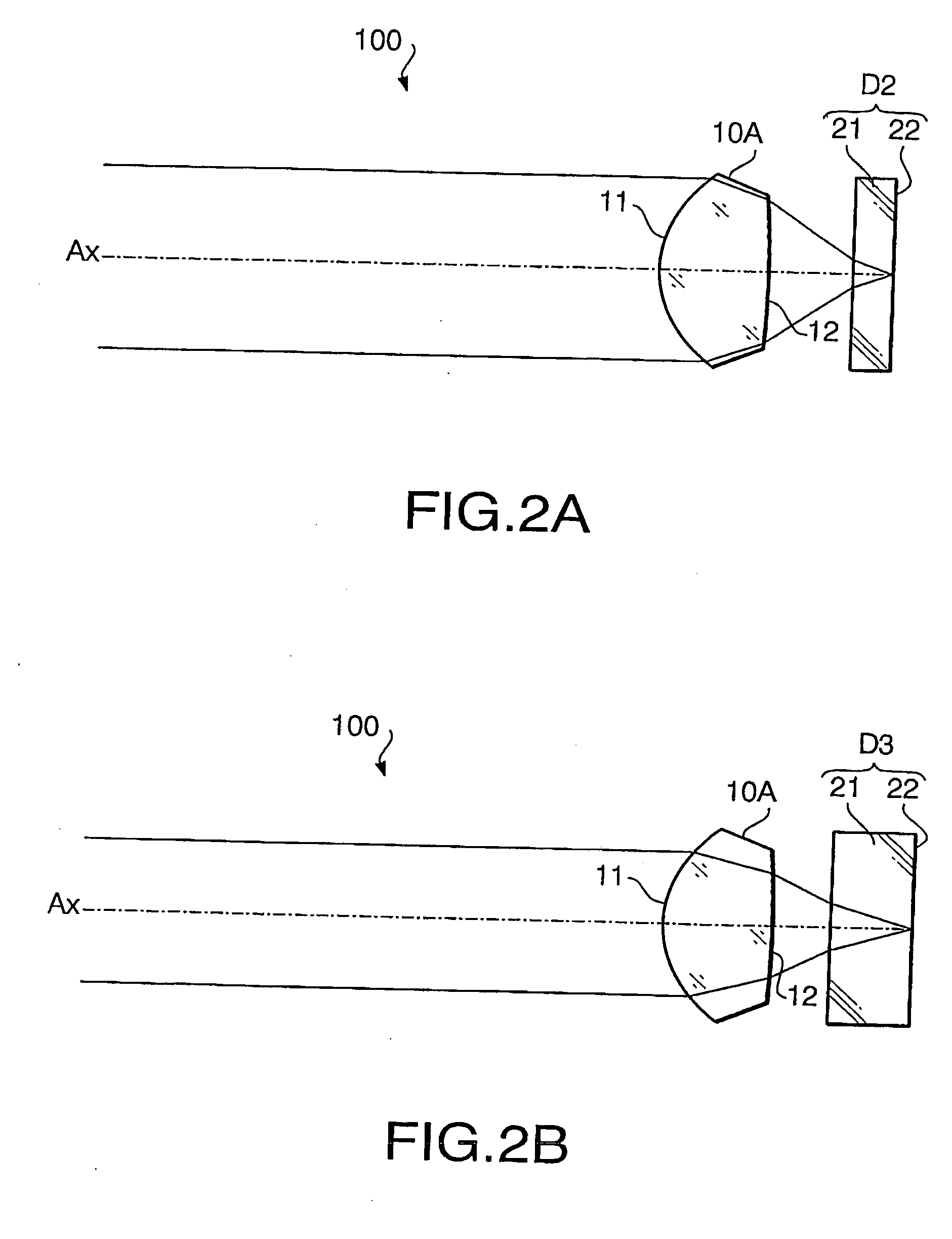Method of optical element and objective lens
a technology of optical elements and objective lenses, applied in the field of optical element design methods, can solve the problems of inability to correct function, limited degree of freedom for design of diffracting structures, and inability to achieve correct function, etc., and achieve the highest recording density, high light usage efficiency, and excellent compatibility
- Summary
- Abstract
- Description
- Claims
- Application Information
AI Technical Summary
Benefits of technology
Problems solved by technology
Method used
Image
Examples
first embodiment
[0160] Hereafter, a design method according to a first embodiment and an objective lens 10A formed according to the design method will be described. The objective lens 10A can be used for two types of optical discs (i.e., the objective lens 10A has compatibility for the two types of optical discs). In this embodiment, the objective lens 10A is configured to support the optical discs D2 and D3. However, an objective lens of a different type having compatibility for another pair of optical discs may be designed by the design method according to the first embodiment.
[0161]FIG. 1 shows a general configuration of an optical disc drive (an optical system) 100 according to the first embodiment. The optical disc drive 100 includes a light source 2A emitting the second laser beam for the optical disc D2, a light source 3A emitting the third laser beam for the optical disc D3, coupling lenses 2B and 3B, a beam splitter 41, a half mirror 43, a light receiving unit (sensor) 44 and the objectiv...
second embodiment
[0203] Hereafter, a design method according to a second embodiment and an objective lens 10B formed by the design method according to the second embodiment will be described. The objective lens 10B is able to support three types of optical discs (i.e., the objective lens 10B has compatibility for the three types of optical discs). In this embodiment, the objective lens 10B is configured to support the optical discs D1, D2 and D3. In FIG. 4 (and in the following drawings), to elements which are equivalent to those of the first embodiment, the same reference numbers are assigned, and explanations thereof will not be repeated.
[0204]FIG. 4 shows a general configuration of an optical disc drive (an optical system) 200 according to the second embodiment. The optical disc drive 200 includes a light source 1A emitting a first laser beam for the optical disc D1, the light source 2A emitting the second laser beam for the optical disc D2, the light source 3A emitting the third laser beam for ...
third embodiment
[0213] Hereafter, a design method according to a third embodiment and an objective lens 10C (see FIG. 4) formed by the design method according to the third embodiment will be described. The objective lens 10C is able to support three types of optical discs (i.e., the objective lens 10C has compatibility for the three types of optical discs), and to cancel the spherical aberration which varies depending on the wavelength shift caused when each of the optical discs D1, D2 and D3 is used. That is, a diffracting structure formed on the objective lens 10C has both the three wavelength compatibility function and the wavelength shift compensation function. Since the configuration of the optical disc drive 200 shown in FIGS. 4, 5A, 5B and 5C is also applied to an optical disc drive according to the third embodiment, the configuration of the optical disc drive according the third embodiment will be explained with reference to FIGS. 4, 5A, 5B and 5C.
[0214] Hereafter, the design method of des...
PUM
| Property | Measurement | Unit |
|---|---|---|
| wavelength | aaaaa | aaaaa |
| wavelength | aaaaa | aaaaa |
| thickness | aaaaa | aaaaa |
Abstract
Description
Claims
Application Information
 Login to View More
Login to View More - R&D
- Intellectual Property
- Life Sciences
- Materials
- Tech Scout
- Unparalleled Data Quality
- Higher Quality Content
- 60% Fewer Hallucinations
Browse by: Latest US Patents, China's latest patents, Technical Efficacy Thesaurus, Application Domain, Technology Topic, Popular Technical Reports.
© 2025 PatSnap. All rights reserved.Legal|Privacy policy|Modern Slavery Act Transparency Statement|Sitemap|About US| Contact US: help@patsnap.com



